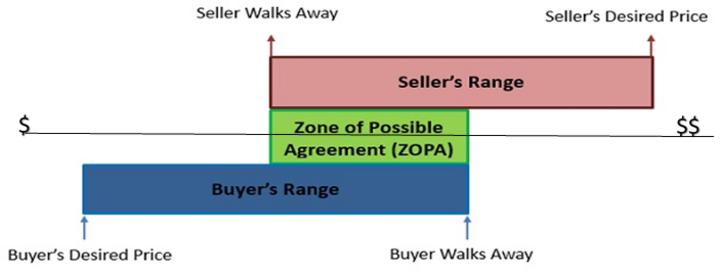From buying new equipment to countering your child’s request to stay up another 20 minutes, everyone negotiates. This series is designed to provide helpful tips and tricks to use and watch out for when negotiating. See more articles in this series.
A phrase made famous by Roger Fisher and William Ury, ZOPA stands for Zone of Possible Agreement. (Fisher and Ury co-authored Getting to Yes: Negotiating Without Giving In.) Another way to describe it is identifying the bargaining range or the field of play in which the two parties are about to enter. (See Figure 1.)
We start with a horizontal price axis. As we move from left to right along the line, the price increases. Now we need to define the range within which both the seller and the buyer are operating. Above the price axis we will identify the seller. When creating the seller’s range, we are interested in two main pieces of information. The first is the desired price. If everything were coming up in the seller’s favor, what number does the seller realistically want to achieve? The second piece of information is at what point the seller will walk away. This walk-away will usually tie in with their BATNA (Best Alternative to a Negotiated Agreement), which we’ll discuss in next week’s article. With those two pieces we can create a Seller’s Range of possible prices. Below the price axis we will do the same for the buyer, again using two pieces of information: 1) At what price will the buyer walk away? and 2) What is the desired price the buyer wants to pay?

Figure 1 illustrates a range of prices above the seller’s walk-away, but below the buyer’s walk-away where the two ranges “overlap.” This is the ZOPA or bargaining range. If done correctly, this is where a negotiator can expect a deal. Having this completed before a negotiation helps combat against the other side trying to influence you by setting a high anchor price. Remember though that when done as preparation to a negotiation, there is the possibility that your identified ZOPA is incorrect and you will need to adjust it on the fly. Asking questions and using active listening to define the criteria in their valuation process will help.
What if there is no ZOPA?
Most individuals look at the ZOPA and think, “I have been doing that for years.” We might not write it down, or map it out, but most of us have a general idea of where we think the ZOPA is before negotiating. Here is a curve ball though. What if you are mapping out the ZOPA and find that your negotiation prep working is showing that there is no ZOPA! The seller’s walk-away price of $13,500 is higher than the buyer’s walk-away price of $11,750. In traditional bargaining, you might as well not even go to the table. Remember, in traditional bargaining we are in a fixed state of mind. There is a defined, unchangeable value and the purpose of the negotiation is to decide what portion goes to me and what portion goes to them. This is the beauty and superiority of interest-based negotiation. While there might not be a ZOPA on paper, if you can discover the other side’s interests and expand the pie to create value for them, that could bridge the gap. Consider whether something has a high interest value to them, but a low interest value to you.
If you have questions about ZOPA or other negotiation topics, please contact me.

